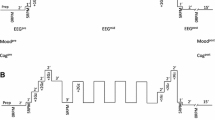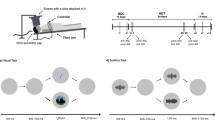Abstract
The effects of a ground-based model of microgravity on executive functions (namely, inhibition) were investigated in this study. Volunteers participated in so-called dry immersion (DI), during which they spent 21 days in a water-filled tub in the supine position. During this period, they performed an auditory Go/NoGo task while multichannel EEG activity was recorded. The Go/NoGo task was performed one time outside of the DI and two times during the stay in the DI. ERPs were computed on correct NoGo and Go trials. While no behavioral deterioration of the Go/NoGo task was found during their stay in the DI, a significant difference was found in amplitudes between NoGo N2 ERP peaks before DI and during DI. The N2 peak was smaller on the 17th day of DI, indicating a potentially lower level of inhibitory control during simulated microgravity conditions. The amplitudes of the N1 and P3 peaks did not change significantly. The dry immersion procedure reproduces some of the important physiological factors of real space flights (support withdrawal, bodily liquid redistribution), thus our results hint at possible brain and behavioral alterations in real space flight that have so far been unnoticed.




Similar content being viewed by others
Data Availability
The ERPs generated and analysed during the presented study are not publicly available but are available from the corresponding author on reasonable request.
References
Albert, J., López-Martín, S., Hinojosa, J.A., Carretié, L.: Spatiotemporal characterization of response inhibition. NeuroImage. 76, 272–281 (2013). https://doi.org/10.1016/j.neuroimage.2013.03.011
Amirova, L., Navasiolava, N., Rukavishvikov, I., Gauquelin-Koch, G., Gharib, C., Kozlovskaya, I., Custaud, M.-A., Tomilovskaya, E.: Cardiovascular System under simulated weightlessness: Head-Down Bed Rest vs. Dry Immersion. Front. Physiol. 11 (2020). https://doi.org/10.3389/fphys.2020.00395
Barkaszi, I., Ehmann, B., Tölgyesi, B., Balázs, L., Altbäcker, A.: Are head-down tilt bedrest studies capturing the true nature of spaceflight-induced cognitive changes? A review. Frontiers in Physiology, 13. https://www.frontiersin.org/articles/ (2022). https://doi.org/10.3389/fphys.2022.1008508
Cebolla, A.M., Petieau, M., Dan, B., Balazs, L., McIntyre, J., Cheron, G.: Cerebellar contribution to visuo-attentional alpha rhythm: Insights from weightlessness. Sci. Rep. 6(1) (2016). https://doi.org/10.1038/srep37824
Cheng, C.-H., Tsai, H.-Y., Cheng, H.-N.: The effect of age on N2 and P3 components: A meta-analysis of Go/Nogo tasks. Brain Cogn. 135, 103574 (2019). https://doi.org/10.1016/j.bandc.2019.05.012
Cheron, G., Leroy, A., De Saedeleer, C., Bengoetxea, A., Lipshits, M., Cebolla, A., Servais, L., Dan, B., Berthoz, A., McIntyre, J.: Effect of gravity on human spontaneous 10-Hz electroencephalographic oscillations during the arrest reaction. Brain Res. 1121(1), 104–116 (2006). https://doi.org/10.1016/j.brainres.2006.08.098
Clément, G., Moudy, S.C., Macaulay, T.R., Bishop, M.O., Wood, S.J.: Mission-critical tasks for assessing risks from vestibular and sensorimotor adaptation during space exploration. Front. Physiol. 13, 1029161 (2022). https://doi.org/10.3389/fphys.2022.1029161
De la Torre, G.G.: Cognitive neuroscience in space. Life: Open. Access. J. 4(3), 281–294 (2014). https://doi.org/10.3390/life4030281
Delorme, A., Mullen, T., Kothe, C., Akalin Acar, Z., Bigdely-Shamlo, N., Vankov, A., Makeig, S.: EEGLAB, SIFT, NFT, BCILAB, and ERICA: New Tools for Advanced EEG Processing [Research Article]. Computational Intelligence and Neuroscience (2011). https://doi.org/10.1155/2011/130714 Hindawi
Diamond, A.: Executive functions. Ann. Rev. Psychol. 64, 135–168 (2013). https://doi.org/10.1146/annurev-psych-113011-143750
Dong, F., Li, X., Zhang, Y., Jia, S., Zhang, S., Xue, T., Ren, Y., Lv, X., Yuan, K., Yu, D.: Abnormal resting-state EEG power and impaired inhibition control in young smokers. Neurosci. Lett. 761, 136120 (2021). https://doi.org/10.1016/j.neulet.2021.136120
Fogarty, J.S., Barry, R.J., Steiner, G.Z.: The First 250 ms of Auditory Processing: No evidence of early Processing Negativity in the Go/NoGo Task. Sci. Rep. 10(1) (2020). https://doi.org/10.1038/s41598-020-61060-9
Hummel, F., Andres, F., Altenmüller, E., Dichgans, J., Gerloff, C.: Inhibitory control of acquired motor programmes in the human brain. Brain: J. Neurol. 125(Pt 2), 404–420 (2002). https://doi.org/10.1093/brain/awf030
Huster, R.J., Enriquez-Geppert, S., Lavallee, C.F., Falkenstein, M., Herrmann, C.S.: Electroencephalography of response inhibition tasks: Functional networks and cognitive contributions. Int. J. Psychophysiology: Official J. Int. Organ. Psychophysiol. 87(3), 217–233 (2013). https://doi.org/10.1016/j.ijpsycho.2012.08.001
Kirenskaya, A., Tomilovskaya, E., Novototskii-Vlasov, V., Kozlovskaya, I.: The effects of simulated microgravity on characteristics of slow presaccadic potentials. Hum. Physiol. 32, 131–139 (2006). https://doi.org/10.1134/S0362119706020022
Klimesch, W.: Alpha-band oscillations, attention, and controlled access to stored information. Trends Cogn. Sci. 16(12), 606–617 (2012). https://doi.org/10.1016/j.tics.2012.10.007
Krittanawong, C., Singh, N.K., Scheuring, R.A., Urquieta, E., Bershad, E.M., Macaulay, T.R., Kaplin, S., Dunn, C., Kry, S.F., Russomano, T., Shepanek, M., Stowe, R.P., Kirkpatrick, A.W., Broderick, T.J., Sibonga, J.D., Lee, A.G., Crucian, B.E.: Human Health during Space Travel: State-of-the-art review. Cells. 12(1), 40 (2022). https://doi.org/10.3390/cells12010040
Lazarev, I.: Event-related potentials accompanying performance of computer mouse pointing task in the long-term dry immersion model of microgravity. Acta Astronaut. 181, 461–467 (2021). https://doi.org/10.1016/j.actaastro.2021.01.040
Lazarev, I.E., Tomilovskaya, E.S., Kozlovskaya, I.B.: Resting state brain activity during long-term dry immersion. Aerosp. Med. Association. (2018). https://doi.org/10.3357/AMHP.4972.2018
Lopez-Calderon, J., Luck, S.J.: ERPLAB: An open-source toolbox for the analysis of event-related potentials. Front. Hum. Neurosci. 8, 213 (2014). https://doi.org/10.3389/fnhum.2014.00213
Manzey, D., Lorenz, B.: Mental performance during short-term and long-term spaceflight. Brain Res. Rev. 28(1–2), 215–221 (1998). https://doi.org/10.1016/S0165-0173(98)00041-1
Michael, A.P., Otto, C., Reschke, M.F., Hargens, A.R.: (Ред.). Spaceflight and the Central Nervous System: Clinical and Scientific Aspects. Springer International Publishing. (2022). https://doi.org/10.1007/978-3-031-18440-6
Miyake, A., Friedman, N.P.: The Nature and Organization of Individual Differences in Executive Functions: Four general conclusions. Curr. Dir. Psychol. Sci. 21(1), 8–14 (2012). https://doi.org/10.1177/0963721411429458
Navasiolava, N.M., Custaud, M.-A., Tomilovskaya, E.S., Larina, I.M., Mano, T., Gauquelin-Koch, G., Gharib, C., Kozlovskaya, I.B.: Long-term dry immersion: Review and prospects. Eur. J. Appl. Physiol. 111(7), 1235–1260 (2011). https://doi.org/10.1007/s00421-010-1750-x
Pechenkova, E., Nosikova, I., Rumshiskaya, A., Litvinova, L., Rukavishnikov, I., Mershina, E., Sinitsyn, V., Van Ombergen, A., Jeurissen, B., Jillings, S., Laureys, S., Sijbers, J., Grishin, A., Chernikova, L., Naumov, I., Kornilova, L., Wuyts, F.L., Tomilovskaya, E., Kozlovskaya, I.: Alterations of functional brain connectivity after long-duration spaceflight as revealed by fMRI. Front. Physiol. 10, 761 (2019). https://doi.org/10.3389/fphys.2019.00761
Reschke, M.F., Clément, G.: Vestibular and Sensorimotor Dysfunction during Space Flight. Curr. Pathobiology Rep. 6(3), 177–183 (2018). https://doi.org/10.1007/s40139-018-0173-y
Shishkin, N., Kitov, V., Sayenko, D., Tomilovskaya, E.: Sensory organization of postural control after long term space flight. Front. Neural Circuits. 17, 1135434 (2023). https://doi.org/10.3389/fncir.2023.1135434
Sosnina, I.S., Lyakhovetskii, V.A., Zelenskiy, K.A., Shoshina, I.I., Karpinskaya, V.Y., Tomilovskaya, E.S.: The Effect of a 21-Day dry immersion on Ponzo and Müller–Lyer illusions. Hum. Physiol. 47(1), 51–59 (2021). https://doi.org/10.1134/S0362119721010138
Takács, E., Barkaszi, I., Czigler, I., Pató, L.G., Altbäcker, A., McIntyre, J., Cheron, G., Balázs, L.: Persistent deterioration of visuospatial performance in spaceflight. Sci. Rep. 11, 9590 (2021). https://doi.org/10.1038/s41598-021-88938-6
Thoolen, S., Strangman, G.: Cognitive Performance and Neuromapping. В A. P. Michael, C. Otto, M. F. Reschke, & A. R. Hargens (ed.), Spaceflight and the Central Nervous System: Clinical and Scientific Aspects (сс. 33–54). Springer International Publishing. (2022). https://doi.org/10.1007/978-3-031-18440-6_4
Tomilovskaya, E.S., Kirenskaya, A.V., Lazarev, I.E., Novototskii-Vlasov, V.Y., Kozlovskaya, I.B.: The influence of support withdrawal on presaccadic EEG potentials in subjects with different asymmetry profiles. Hum. Physiol. 36(7), 818–822 (2010). https://doi.org/10.1134/S0362119710070121
Tomilovskaya, E., Shigueva, T., Sayenko, D., Rukavishnikov, I., Kozlovskaya, I.: Dry immersion as a ground-based model of microgravity physiological effects. Front. Physiol. 10 (2019). https://doi.org/10.3389/fphys.2019.00284
Xu, P., Wu, D., Zhou, Y., Wu, J., Xiao, W.: An event-related potential (ERP) study of the transfer of response inhibition training to interference control. Exp. Brain Res. 239(4), 1327–1335 (2021). https://doi.org/10.1007/s00221-021-06055-2
Acknowledgements
We would like to thank our colleagues in the Laboratory of Gravitational Physiology of the Sensorimotor System for organizing the Dry Immersion procedure.
Funding
This study was supported by the Russian Academy of Sciences (63.1).
Author information
Authors and Affiliations
Contributions
Ivan Lazarev collected and analyzed the data and wrote the manuscript.
Corresponding author
Ethics declarations
Ethical Approval
The study was approved by the local ethics committee of the Institute of Biomedical Problems. All procedures performed in studies involving human participants were in accordance with the 1964 Helsinki declaration and its later amendments or comparable ethical standards. Participants took part in the study for a fee and were recruited among the Institute of Biomedical Problems staff and through social networks.
Consent to Participate
Informed and written consent was obtained from all individual participants included in the study.
Consent to Publish
Not applicable (information is anonymized and the submission does not include images that may identify the person).
Competing Interests
The author declares that they have no known competing financial interests or personal relationships that could have appeared to influence the work reported in this paper.
Additional information
Publisher’s Note
Springer Nature remains neutral with regard to jurisdictional claims in published maps and institutional affiliations.
Rights and permissions
Springer Nature or its licensor (e.g. a society or other partner) holds exclusive rights to this article under a publishing agreement with the author(s) or other rightsholder(s); author self-archiving of the accepted manuscript version of this article is solely governed by the terms of such publishing agreement and applicable law.
About this article
Cite this article
Lazarev, I.E. Auditory Go/NoGo Task in the Dry Immersion Model of Microgravity. Microgravity Sci. Technol. 36, 32 (2024). https://doi.org/10.1007/s12217-024-10118-8
Received:
Accepted:
Published:
DOI: https://doi.org/10.1007/s12217-024-10118-8




